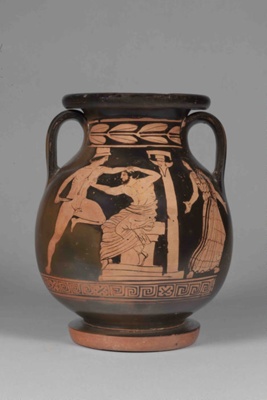< Collection search
< Collection highlights
From:UC Teece Museum of Classical Antiquities
Name/TitlePelike
About this objectThis pelike, used for storing wine or water, is similar to an amphora in purpose and style; however, unlike an amphora, this vase flanged so it can stand on its own.
One interpretation of Side A of the vase is that it possibly depicts the death of Aegisthus. While Agamemnon was at the Trojan War, his wife Clytemnestra took Aegisthus as a lover. When Agamemnon returned to Mycenae, the pair murdered him in his bath and went on to reign over the city. Agamemnon's son Orestes then murdered them in retaliation for his father's death.
The painter of this vase has captured the moment just before Aegisthus' death. Aegisthus sits on an altar in the centre of the scene with a hand reached out in supplication. Behind the altar is a column with a boukranion (sculptured ornament of an ox skull) hanging from it. On the left is Orestes, naked but for the pilos cap on his head. He holds a machaira (a dagger) in his right hand and seizes Aegisthus by the hair. The figure of Aegisthus wears a himation (a cloak) that has slipped down to his waist and has sandals on his feet.
Meanwhile, a female figure flees to the right with a gesture of despair and an expression of fear on her face. She is may be meant to be Clytemnestra, running from her son, but Orestes' sister Electra is another possibility. It has also been suggested this figure may be a member of a chorus. She wears a decorated peplos.
Meanwhile, Side B shows a scene with three cloaked youths. There is no myth associated with the trio. This may have been meant to provide contrast to the intensity of the other side.
The vase is attributed to the Vaste Painter, who was a follower of the Amykos Painter, but his style is cruder than that of his teacher. The vase painter may have been inspired by the play 'Electra' written by Euripides in ca. 410 BCE, in which the hero Orestes kills Aegisthus at an altar.
MakerAttributed to the Vaste Painter
Maker RoleArtist
Date Madeca. 380 BC
PeriodClassical
Medium and MaterialsCeramic: Pottery
Style and IconographyLucanian
Style and IconographyRed-figure
TechniqueSlip trailing (relief line)
TechniqueThrowing (pottery technique)
MeasurementsHeight 247mm; Diameter 197mm
Subject and Association KeywordsTheatre in art
Subject and Association KeywordsClothing and dress
Subject and Association KeywordsWomen in art
Subject and Association KeywordsMurder
Subject and Association KeywordsViolence in art
Named CollectionThe James Logie Memorial Collection, University of Canterbury, New Zealand
Credit LinePurchased, 1973.
Object TypeContainers
Object number156.73
Copyright LicenceAll rights reserved
